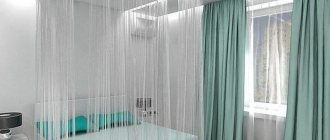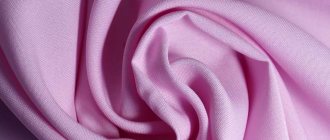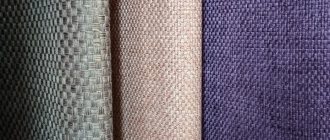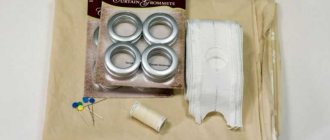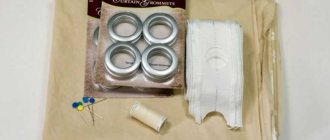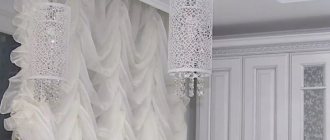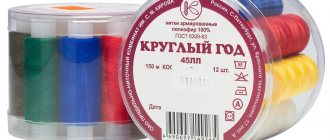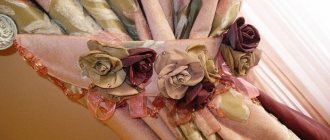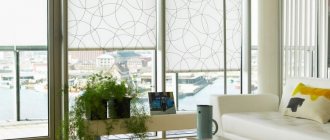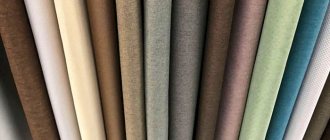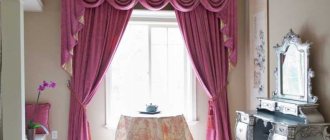Features of microvoile fabric
Microveil is a type of tulle. The fabric is a light, almost weightless, translucent material thinner than silk. It has a light matte shine. At first glance, a microveil can be confused with a veil. But in fact, it combines the properties of both a veil and organza. The fabric took on softness and airiness from the veil, and elasticity and light transmission from organza.
Typically, this fabric is used to make window curtains, bed curtains, or used for room decoration.
The difference between microvoile fabric and veil, organza and semi-organza
The main difference between these fabrics is their structure. All fabrics are light, soft, airy, translucent or transparent. The veil fabric has a mesh structure. It is softer and denser than microveil or organza. It is less transparent and can be used to darken a room. Still, the main use of the veil remains sewing wedding dresses and photographs. Organza, in turn, is a completely transparent fabric with a slight sheen. Curtains made of this fabric are transparent and completely transmit sunlight. We can say that a microveil is something between organza and a veil; it combines their softness and light shine.
Semi-organza, in turn, differs from microveil in the type of shine. In the microveil it is a dotted metallic one, while in the semi-organza it is a muted mother-of-pearl. Which of the above fabrics is better? It is impossible to judge, because often their functions may differ. What to do when you need to decide on the choice of material? An important argument in this case is the price. The micro veil wins here.
Organza - basic properties, pros and cons.
Organza is a thin, light and very transparent fabric. From a technological point of view, it is a combination of natural silk material with the addition of synthetic fibers. Most often, the same polyester is used as an additive, but sometimes it is replaced with viscose.
The technology for making organza is very complex and labor-intensive; the material goes through several phases of very specific processing. This explains the high cost of such fabrics, but in fairness it should be noted that the price of organza is fully justified by its quality and remarkable decorative properties.
For example, despite its external lightness, organza is characterized by high strength and elasticity. Such curtains are very wear-resistant and, with proper handling and proper care, can last for many years.
Modern industry produces a large number of varieties of organza. It can be plain or patterned, matte or shiny, crinkled, perforated, sprayed, etc. Not so long ago, chameleon organza appeared - the fabric can change its color when the lighting or viewing angle changes.
Professional designers consider the advantages of organza to be transparent and airy, as well as good compatibility with most curtain fabrics. Organza does not require special care, it does not attract dust, and can be easily washed if necessary. When exposed to direct sunlight for a long time, this material does not fade, maintaining its original appearance.
However, organza cannot be called an ideal material for curtains, as it has disadvantages. The main disadvantage is that puffs and other minor defects that may form on the surface of the fabric cannot be repaired. Therefore, it is not recommended to use organza in homes with active pets.
History of the origin of microvoile fabric
Microvoile fabric entered the textile market quite recently, in the middle of the last century, along with the ability to produce very thin synthetic threads. Fabric is considered a new, improved material. Now the largest production of this fabric is allocated to China, South Korea, Russia, Turkey and Italy. And the most popular brands are two Turkish fabrics “Interio” and “Adele”.
How to hem?
To hem curtains and tulle, you need scissors, thread, a sewing machine and an iron. If you have ceilings of the same height throughout the entire area of the room, then you can align the lower edge of the tulle curtains by pulling out one horizontal thread, and then cut the fabric along this guideline with scissors.
Since tulle is a sliding material that constantly warps, it is recommended to mark from the edge the length required for hemming every 20 cm and run a thread of a contrasting color along the marks. Cut off the edge along it.
- You need to thread the machine with threads no thicker than size 40. If the organza tulle is shiny, then it is better to choose threads two shades lighter. In sunlight they will not be visible on the fabric because a lighter tone does not stand out as much as a darker one.
The needle in the machine should be sharp and thin so as not to catch the fabric.
- Before you put the machine on the table, you need to cover it with a sheet. With cotton, the tulle curtain will not slide or warp, and sewing will be much easier.
- Before hemming, adjust the sewing machine stitch on the scrap piece of fabric. If the fabric is very thin and clings to the machine, hem it on tissue paper or tracing paper. After finishing the work it is torn off.
- Work begins with the side edges, bending them 1-2 cm and ironing them, stitching at a distance of 1-2 mm from the inner edge of the hem.
- If the curtains have lace or festoons at the bottom, then the length is adjusted at the top.
- The organza is hemmed at least 3 cm into the hem, that is, when cutting the length, you must leave a 6 cm allowance. The veil is hemmed by 2 cm, that is, a 4 cm allowance from the desired length.
You will learn even more information about hemming organza tulle from the video below.
How to care for microvoile fabric
Microveil is quite easy to care for. Due to its structure, the fabric does not accumulate dust and there is no need for frequent washing. Products made from micro-veil can be washed in a washing machine on a delicate cycle at a temperature not exceeding 30 degrees. Choose washing powders and gels that do not contain chlorine. The washing machine drum can damage the fabric, so choose the minimum speed setting. Products made from this fabric dry quite quickly. During drying, carefully hang the product on a drying rack or line. The microveil fabric does not wrinkle, but if necessary, you can smooth the material with an iron in the “synthetic” mode.
So, as we can see, caring for microveil fabric is not at all difficult. If you follow the above rules, products made from this material will serve you for a long time.
Features of choosing tulle in the living room
Correctly selected curtains will help create a cozy home environment in the living room, conducive to relaxation or, on the contrary, make this room stylish and creative. Here are some recommendations from designers for decorating windows:
- For curtains and curtains, it is better to choose fabrics that match not only color, but also texture. For example, organza is more suitable for satin or brocade curtains, and a veil is more suitable for jacquard or velvet curtains.
- For a room with patterned wallpaper, you should choose plain curtains.
- Curtains made of voile in combination with curtains made of matting will fit well into a room decorated in the style of “country” or Provence, and in combination with tapestry - for “Baroque” or “classic”.
- Shiny organza will look best in a room with an oriental flavor, while matte organza will look best in rooms decorated in a Scandinavian style.
- If the living room is large, then you should choose curtains in dark colors, which will visually narrow the space. And the smaller the room, the lighter the curtains and curtains should be.
So, veil or organza, which is better for sewing curtains for windows. There is no definite answer to this question, since both fabrics have an attractive appearance and good functional qualities. Therefore, the right to choose remains with your desires, namely what you want to see on your window and how to combine it.
Scope of application of the veil
Cotton veil is used for sewing wedding dresses. A veil or veil is made from synthetic material to complement the look.
The veil adds romance to the bride's outfit. It is attached to a hat or a bun of hair with hairpins and covers the face. The veil is decorated with fresh flowers, sequins, and shiny braid.
A veil is a must-have accessory for a classic bride's look. It can be made short or long and decorated with rhinestones, lace, and beads. The veil is attached to the hair with invisible threads.
View this post on Instagram
Posted by Jacqueline Wedding Salon (@jaklinsalon) Sep 19, 2019 at 1:14 PDT
Hats with small veils create a special style of the 19th century. Such veils are made very short, reaching to the tip of the nose. Black veils, decorated with lace or a pattern, look strict and add sophistication to the look.
View this post on Instagram
Publication from Photographer Tolyatti & Samara (@mentugova_natalia) December 4, 2021 at 10:00 PST
Hats and hair accessories are made from thick fabric. Small pillbox hats decorated with feathers or artificial flowers look elegant. Voluminous veil flowers look beautiful on long hair.
In the video, making flowers from airy material:
Muslim women also use the fabric. A burqa and veil are sewn from a dark thick veil.
The interiors are decorated mainly with synthetic fabric. It has a wide variety of shades, which allows you to create many designs.
In the interior, the veil is used as:
- curtains for windows;
- decorating openings between rooms;
- canopies;
- covers for furniture.
The veil for curtains can be chosen in any color. However, it should be taken into account that colored fabrics fade when exposed to sunlight. Therefore, it is better to place bright curtains on windows with minimal lighting.
Thanks to the plasticity of the fabric, curtains can be designed in different ways:
- classic - rectangular canvas, hanging freely and forming folds;
- lambrequin - a horizontal short curtain thrown over a cornice;
- Italian curtain - folded and thrown over the cornice or secured with a weighting ring;
- French curtain - decorated with symmetrical flounces.
View this post on Instagram
Publication from Irina (@len_spb) May 31, 2021 at 12:53 PDT
Voluminous curtains look unusual. To make them, you need to sew curtain tape along the edge of the canvas. This can be done by machine or by hand, and you need to bend the edge of the canvas.
Then the thread is pulled from the tape, due to which the fabric is gathered in voluminous folds.
The video contains secrets on how to sew curtain tape:
Features of cutting and sewing from a veil
The material is used mainly for the manufacture of large products - curtains, tulle. It is difficult to carefully cut a large canvas at home. They use the “thread by thread” cutting method.
The required width is marked on the canvas. A small cut is made along the edge and one thread is carefully pulled out. A path is formed along which the material can be cut evenly.
Before sewing, the edges of the panels must be aligned in this way. Otherwise, the finished product will curl and skew to one side.
The open edges of the panels are processed with a hem seam, an overlock stitch, or a linen seam. The product will be decorated with a narrow satin ribbon edging the seam.
Sewing curtains for the kitchen:
Comparison of organza and veil materials: which looks better
A veil looks better in clothes. It is not so transparent, flows well and easily flows around various shapes. This material also looks better as curtains, creating a light atmosphere in the room.
Organza is an acquired taste, both in clothing design and in interior design. This is a tough material, it doesn’t look so organic in clothes, but it’s good for creating durable and practical curtains.
What is the difference between a veil and organza
These materials vary significantly in appearance, composition and manufacturing method. Pay more attention to study their differences in detail before making your choice.
External differences
Let's start with external signs, since they are the first thing people pay attention to.
| Veil | Organza |
| Soft, flowing; allows you to make folds of various configurations | Stiff, fits only in large folds |
| Translucent | Has a high degree of transparency |
| Doesn't shine | Has a slight shine and shimmer |
It is also worth mentioning that dirt is more visible on the veil, and it is more difficult to clean.
Features of the composition of “veil” and “organza” fabrics
Most often, the veil is made from a cotton base or polyester. They are the most affordable in price and quality. It can also be made of silk or wool, but these types are rare and very expensive.
Organza appears thanks to the technique of twisting two fibers. The composition includes silk, polyester and viscose.
What is a microveil?
Microveil combines the positive qualities of a veil - softness, sophistication - and organza - light transmission, elasticity. At the same time, microveil is a new type of fabric that deserves special attention. Possessing amazing thinness and transparency, semi-organza is incredibly flexible and durable; moreover, it is not subject to deformation, shrinkage and is resistant to ultraviolet rays. If you are looking for a thin fabric that can be draped into beautiful folds, microvoile is for you.
